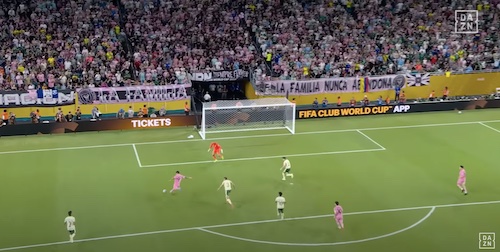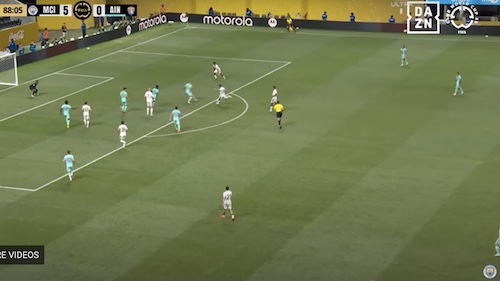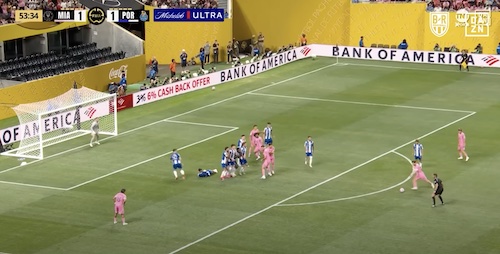By Tom Sheldrick
Yes, it’s true. Football is for the young. “How old was Michael Owen?” That’s a sentence that’s surely missing an important part – “in 1998” for example. I think an awful lot of football fans would already have given you an answer though, without that prompt. He was 18. It was the World Cup, in France, in 1998, when the whippet-like striker burst into global recognition, with that goal against Argentina. Terrifyingly, he’s now 31, and even looks surprised himself when he makes it off the bench.
Watch Michael Owen’s goal versus Argentina.
Wayne Rooney was 16 when he scored that goal against Arsenal, and announced his talent to a broader audience. Now, surrounded by expensively-assembled ‘kids’ at Manchester United, at 25, he’s positively an old-timer, even though this summer’s hair transplant (yes, the British press do need to keep themselves busy with football stories over the off-season) has made him look younger than he did as a teenager.
Watch Wayne Rooney’s goal versus Everton.
Cesc Fabregas remained 17 for an unfeasibly long time, delivering incredibly mature performances in the heart of Arsenal’s midfield. Indeed, had they not been monitoring him quite so closely, Barcelona might not have noticed that in place of the lad who left them as a teenager, it was a man at 24 that they were getting back, an impossibly experienced one at that. The transfer saga went on for so long, it’s amazing he has any of his career left.
There was Freddy Adu, who was 14 when he selected in the MLS Super draft, and still 14 when he played in the MLS for the first time. He was very much the next big thing. Eight years on, and it’s not gone well. On this side of the pond, plenty would name-check but not pick him out of a line-up, and recently he’s only been lusted over on Championship/ Football Manager computer games.
Of course, these tales are all about players who made such a striking breakthrough, were heralded and hyped, and suddenly written-, read-, spoken- and heard-about by journalists and fans. Normally with the addition of: “Can you believe it, he’s only [insert age]?” Now, years on, they’re years older. But so often in your mind that player remains an 18, 17-, 16-, or even 14-year-old in your mind, full of promise and with the best yet to come.
As quickly as you can arrive on the scene, you can disappear from the football scene. Frank Lampard – the kind of player who’s career worked in a steady incline – suddenly woke up and was a 33-year-old at the start of this season, it seems. Left on the bench by England and Chelsea – and surely not helped by the fact that his club manager’s the same age as him – the word ‘veteran’ has started appearing in front of his name, and quickly it’s felt as if it’s always been there. He was at the heart of England’s ‘golden generation’ – they’ve won the lot with their clubs, Steven Gerrard, John Terry, Rio Ferdinand have – whose careers are now slowly starting to slip away, increasingly troubled by injury, usurped by a new breed.
In the drastically short careers that only sportspeople (and perhaps TV presenters) enjoy, there are ways of aging with style. You can change your name from Andy to Andrew (see: Cole, Johnson). If you’re worried people have forgotten about you, you can announce your retirement from international football, even if you never going to be picked again anyway (see: Luke Young, Emile Heskey).
Ryan Giggs’ renaissance made the elder statesman fashionable again, and Sam Allardyce managed to get the best out of 30-something Spaniards at Bolton and then Blackburn. (The most strange thing was the fact that Ivan Campo and Michel Salgado, respectively, were both lured to the north-west of England having won the Champions League with Real Madrid). This summer, top four contenders Spurs signed – and immediately installed as first-choice – a goalkeeper who is 40 years old. Brad Friedel continues to perform at the highest level.
But – goalkeepers aside – as this season now really starts to take shape (you shouldn’t be allowed to look at at league table until at least five games have been played) the clear pattern that’s emerged, both in the transfer sums changing hands and the line-ups chosen on the pitch, is of a faith in and a regard for youth – at least among the big teams.
Arsenal spent £11 million on 18-year-old Alex Oxlade-Chamberlain, Chelsea brought in Juan Mata (23) and Romelu Lukaku (18). Jordan Henderson cost Liverpool £16 million – ostensibly because he’s 21. Manchester City’s Sergio Aguero is still only 23, and neighbors Manchester United spent £50million on three who are under 25.
The wheeling and dealing for older, more experienced players, was left to Stoke, QPR and then, when the word ‘crisis’ was being banded around and there were only hours left before the transfer window shut, Arsenal. Mikel Arteta and Yossi Benayoun may be seen as panic buys – but could also provide the know-how a fragile Arsenal team needs. Arsene Wenger’s policy to offer only short-term contracts to players past 30 may be something he starts to re-think.
In Spain, Barcelona signed Alexis Sanchez, 22, and Real Madrid signed a seven-year-old, Leonel Angel Coira, with his Lionel Messi like first name. A bit of a unique one, perhaps, but the truth is there to see – the market is skewed towards youth. Sell-on-value is rarely forgotten, and the eye always focused on ‘potential.’
Soccer / football players’ careers at the top are getting shorter than ever. With academies such as at Barca scouring for talent, honing skills and teaching values from before boys hit their teenage years, players like Jimmy Bullard who don’t start playing top-flight football until they’re in their late twenties will become ever rarer. At 23 and three-quarters, it might be time for me to recognize that I’m never going to make it either!
Tom Sheldrick is a freelance writer and can be reached at: tms301087@hotmail.com















